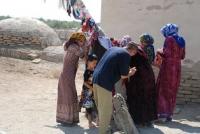Вы здесь
Dash mechet madrasah.

Tours on ancient monuments of Kunya-Urgench.
"Has 19 living rooms (khudjrs) cover the courtyard on perimeter. Medieval settlement of Urgench. Already in Urgench was the largest and second most important city in medieval Khorezm after Kyatom, and after the destruction of the waters of the Amu Darya Kyata became the capital of the Khorezm Mamunidov dynasty"
Hiking group tours in Turkmenistan.
In ancient Kunya-Urgench, in 80 meters to the east of Nadzhmeddin Kubra mausoleum there is a madrasah of Dash mechet.
The building is built in 1907 - 1908 for Mahomed-Amin at the expense of the treasury of the Khivan khan as madrasah including the room of the mosque. Madrasah - the one-storey building, in brick facing, with the high portal and four decorative towers on corners.
Has 19 living rooms (khudjrs) cover the courtyard on perimeter. Medieval settlement of Urgench. Already in Urgench was the largest and second most important city in medieval Khorezm after Kyatom, and after the destruction of the waters of the Amu Darya Kyata became the capital of the Khorezm Mamunidov dynasty.
With them, especially in the XI - XII centuries. Turkic dynasty in the reign of Khorezm is erected fortifications, the town built up with rich houses, palaces, markets, houses of Muslim worship. The Mongol invasion (1221) resulted in Urgench in decline, but at the end of XIII - XIV century town again on the rise, it becomes almost independent of the system who Gold Orda Khanate.
This period is marked by the intensive construction of monumental buildings. Five-time raids by Timur (1372 - 1388) Urgench was almost razed to the ground, it remained only a few cult-memorial structures. A revival of construction activity is celebrated here in the XVI century.
But in the future the city withers and finally to the XVIII century. turns into a mound Old Urgench.
Authority:
On materials of information department of the State committee of Turkmenistan on tourism and sport. "Religious and spiritual monuments to Central Asia". Author M. Hashimov. Saga publishing house, 2001.
Photos:
Alexander Petrov







